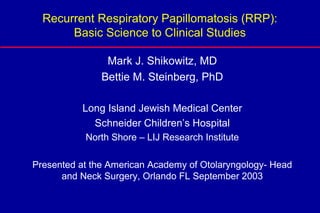
Lij research 2003
- 1. Recurrent Respiratory Papillomatosis (RRP): Basic Science to Clinical Studies Mark J. Shikowitz, MD Bettie M. Steinberg, PhD Long Island Jewish Medical Center Schneider Children’s Hospital North Shore – LIJ Research Institute Presented at the American Academy of Otolaryngology- Head and Neck Surgery, Orlando FL September 2003
- 2. Respiratory Papillomas Benign tumors of airway - larynx > trachea >lungs Caused by Human Papillomaviruses types 6 and 11 Frequently recur - can require more than 100 operations Recurrence due to activation of latent infection Become malignant in approximately 3% of patients Irradiation of papillomas increases malignant conversion – 16-fold increased risk * *Lindeberg H, Elbrond O. Malignant tumours in patients with a history of multiple laryngeal papillomas: the significance of irradiation. Clin Otolaryngol. 16:149-51 1991.
- 3. Appearance of Mild and Severe Larynx Papillomas
- 4. Demographics of RRP International Data − incidence 3.8 - 7.0 / million population/ year − prevalence 1/100,000 − two peaks - juvenile onset 2-5 years of age − adult onset 20-40 years of age − juvenile 1:1 male/female, adult 2:1 LIJ Data − total patients treated 254 − adult onset: 138 juvenile onset: 116 − 175 males, 79 females
- 5. Studies in Laboratory Signal transduction - control of cell growth and differentiation Regulation of latent infection Host immune responses to HPV − T cell functions − Suppression of MHC expression by HPV protein Efficacy of photodynamic therapy – completed Efficacy of Celebrex therapy
- 6. Latency is the Key to This Disease Latency: presence of viral DNA in clinically and histologically normal respiratory tissue Source of recurrent laryngeal disease − recurrence not due to “spread of virus” during surgery − all patients have patchy latent infection in larynx, even if in remission for 20+ years Disease is due to focal activation of latency Cannot cure disease unless eliminate latency - only control
- 7. Papillomavirus Life Cycle Virus Production Normal epithelium (if permissive) Late Viral RNA, DNA Infection squame Early Viral with virus n RNA ati o tiv Viral DNA ac maintenance Papilloma Latent Infection Co-carcinogen(s) Cancer Rare event
- 8. Tracheal Papillomatosis and Tracheal Latency Tracheal disease less frequent than laryngeal disease − 35/254 (13.7%) of our patients have tracheal disease Several possible explanations for low prevalence − Low rate of HPV infection − Low rate of HPV latency − Low rate of activation of latent infection We have asked which of these explanations might be correct
- 9. HPV Latency is Equal in Larynx and Trachea 60 Perent biopsies 40 20 0 Larynx Trachea
- 10. Conclusions - Take Home Message Nearly all patients carry latent tracheal HPV DNA Therefore, low frequency of tracheal disease not due to infection rate or establishment of latency Low rate of tracheal disease must be due to tissue- specific factors required for activation of HPV DNA − Permissive tissue for virus is stratified squamous epithelium − Trachea normally ciliated columnar − Must avoid inducing squamous metaplasia (e.g. trach tube, smoking)
- 11. Design of Photodynamic Therapy Study Patients with 3 or more surgeries in past year or tracheal involvement eligible Randomized - two treatment times (6 and 15 months) after enrollment - late group “control” One dose Foscan® - 0.15 mg/kg Wash-out time 6 days Light dose (652 nm) adults: 80-100J, children: 60-80J Score disease at 3 month intervals for 1+ yr after PDT Study now ended – PDT improved disease for some patients, but did not prevent long-term recurrence
- 12. Results of PDT Study Percent Score at Entry Response to PDT 500 Median and Range 250 Controls - PDT treated 200 150 100 50 3 6 9 12 15 18 3 6 9 12 15 18 21 PDT p= 0.006 Months After Enrollment
- 13. Design New Celebrex Study Multi-centered study, other sites planned − University of Iowa − University of Alabama, Birmingham − University of Pittsburgh Patient enrollment requirement: Adults with 3 or more surgeries in past year or tracheal involvement Randomized - two start times (6 and 12 months) after enrollment - late group “control”, everyone gets Celebrex Celebrex NOT Standard Dose – must be managed carefully as per study Score disease at 3 month intervals for total of 2 years
- 14. Role of Host Immune System in Disease Simple question - why do patients have recurrent disease? Approx. 5% of population carries latent HPV in larynx, RRP prevalence is 1/100,000 Are RRP patients immunocompromised? Answer: No! Standard tests show no defect in immune system and patients no more likely to have other infections. Must be specific for HPV
- 15. Immune Response in RRP Cell-mediated Immunity Humoral Immunity TH1 Cell TH2 Cell Ifn-γ,, IL-2 IL-4, IL-10 CD 8 T-cell (CD28) MHC Class II T-cell receptor B7 with viral protein (MHC Class I) Infected epithelial cell Antigen Presenting Cell
- 16. Take Home Message Many patients have antibodies against HPV Specific defect in the ability of RRP patients to generate a cell-mediated response to HPV infection - not general immune suppression This could explain the ability of the virus to activate latent infection repeatedly without developing an effective immune response Celebrex study will determine whether it improves immune response.